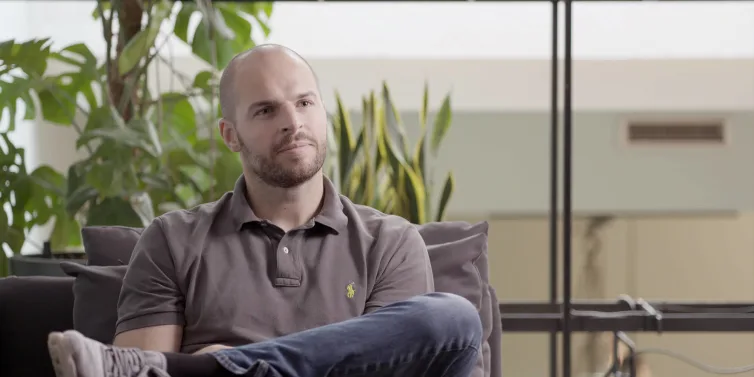A few months back, I was sitting at my desk looking at the impact of push notification campaigns. And I was wondering: how can I be in such a spectacular company while being so spectacularly bored? Then my phone rang.
Fast forward a few weeks. New office, new job at Typeform, and new opportunity to scale up an entire data infrastructure and recruit a team of data scientists and engineers.
Now fast forward to today. Typeform has a team of dedicated data specialists, an integrated data warehouse, and a service-based model that feeds information to every area of the business.
How did we build this so fast? What did we learn? Read on to find out.
Start small and stay in the present
“Throwing a bunch of gifted people in a room doesn’t guarantee they’ll get along and grow into a thriving team.”
We all know the roles that make up a solid analytics department. People like data scientists, data engineers, business analysts, and business intelligence developers.
So, best to open two positions for each role to get hiring over with fast. Right? Wrong.
It’s almost impossible to foresee what a team—and ultimately a company—will need in the near future. Priorities change very quickly at a fast-growing startup. One day you might think you need a business analyst. Twenty-four hours later, you’d rather hire a data architect.
Thankfully, a sense of responsibility compelled me to proceed with care by applying this simple plan: start small and scale the team one member at the time, based on our necessities as they evolve.
Okay, so start small. Then what?
I’m a seasoned data engineer, so I could do most of the initial work myself. And quite honestly, I couldn’t wait to get started. After all, it’s not every day that you get the chance to create an infrastructure from scratch and do things just the way you want.
I’m talking “CREATE TABLE DIM_ACCOUNT AS.” Or for non-data types, absolute zero. But as appealing as it seemed, that kind of task would leave me with no time for anything else.
Plus, I still needed to address the waterfall of requests that I was getting from my stakeholders.
To get the ball rolling, I needed a data scientist.
Stop hunting unicorns
“The different perspectives on the team are an enrichment, everybody wants to learn from each other.”
Here’s one idea: go after the most sought-after profiles on the job market. You see, Barcelona’s streets are paved with the bodies of recruiters who spent half of their adult lives looking for the holy grail of analytics: THE DATA SCIENTIST.
That brainy superhero who’s proficient at pretty much anything, will give you all the answers, and resolve all your problems.
Well guess what. There’s just a handful of these unicorns on the planet, and they’re all busy trying to send people to Mars with Elon Musk.
Instead, use a more realistic approach: create a multidisciplinary team made of young, talented individuals with complementary skills, that happen to get along. Address complexity with diversity—management 3.0 style.
It’s okay to be young
“Not only are we able to be ourselves at work, we’re also encouraged to discover and develop our capabilities according to both our personality and technical skills.”
It didn’t take long for Viola and David to apply for the job. They’re both young, passionate, and gifted—although maybe not quite as experienced as one would have wished.
That said, David did spend two years “cool hunting” through text mining in Italy and then, when he moved to Barcelona, built a statistical model in order to rent the best possible flat. Not bad.
Viola had been working on her master’s thesis in geostatistics in Chile, submitted a job application that could have been a dissertation, and is fluent in four languages. Not too bad either.
We couldn’t quite make up our minds, so we hired both.
Then there’s Francis. He was an ambitious Master’s student in data science who insisted on doing his internship with us. He earned a full-time position shortly after.
“It’s really a pleasure to work with such talented and passionate people answering challenging and important questions.”
Soon, I had a team to manage. And since I could no longer take care of all the engineering myself, we opened a position for a data architect. Srdjan stood out in a pool of more experienced candidates because of his knowledge and passion despite his short career.
Looking beyond experience proved to be a winning bet. Because talent comes in a variety of shapes and forms: curiosity, critical thinking, affinity, passion, drive to improve, empathy, and cultural fit. This includes a whole range of soft skills that, unlike traditional expertise, are not just hard to come by, but even more difficult to learn.
Moreover, having an analytics crew in place helped attract more experienced candidates. Machine Learning veteran Felipe and proven Web Analytics Specialist Colin were happy to jump on board—bringing some seniority to an already-promising team.
Organizing your team: specialization or generalization?
“We have a fantastic flow of ideas—no fear of bringing all kinds of thoughts to the table.”
Now that we had the right people, the next challenge was getting organized. Anyone who’s been in analytics long enough will tell you that, over the past few years, there’s been a transition to more specialized teams.
People now have specific responsibilities. Things like building data pipelines, creating dashboards, analyzing AB tests or marketing campaigns, dealing with business users, or crunching support tickets. This model might work in some contexts, but not in ours.
Here, everyone relies on teammates to grow and overcome their limitations.
Furthermore, through a generalist approach, we make sure that everybody gains a holistic understanding of our business. Today’s companies are highly complex systems where elements influence each other through several intricate dynamics.
For example:
Mastering conversion requires considering acquisition and retention.
Understanding customer churn means listening to the customer voice.
Building features aligned with customer needs is impossible without all of the above.
And so on.
That’s why our data scientists engage in a wide range of projects involving product, design, growth, and customer success. We tackle a variety of problems and help guide major decisions on a daily basis—with absolute freedom of means and strategy.
In order to maximize their effectiveness, the data architect and the data discovery analyst—who support them—are deeply involved in their projects. Rather than working independently, this approach allows them to own a clear picture of why the data they produce is needed, and how it’s consumed.
Once they can walk, let them fly
“I love our morning meetings: there are no taboos and always a great source of ideas.”
With the team reaching maturity, we’ve become a fully self-organized crew. The team has total flexibility in terms of working hours, a 10% share of time reserved for self-learning, regular team workshops, frequent brainstorming, and paired-programming sessions.
And we top that off with some personal time and the highest possible degree of cooperation.
We’re watching the team grow both in terms of performance and responsibility. They handle complex challenges, decide when it’s alright to go to the gym during working hours, and when they should throw in an hour of overtime (despite being discouraged to do so).
“We’re encouraged to think big. Because today’s problems are nothing compared to the challenges we’ll be facing a year from now.”
Recap
If you’re looking to start or grow an analytics team, here’s my top advice:
Hire one person at a time, and base hires on the necessities of the moment.
Build a team with complementary skills who are likely to get along well.
Hire people, not experience.
Value cultural fit in addition to a positive, cooperative attitude.
Let your team experience the entire business.
Give them everything they need to strive.
Watch them grow into success.
Look out for our team’s next blog post on virality for SaaS businesses!
Alessandro Pregnolato is the director of analytics at Typeform. He’s responsible for data operations, data science, and machine learning: empowering Typeform to make the best decisions while promoting a data culture through passionate and effective communication. When not obsessing over data, he’s the lead vocalist and bassist in a rock band.







